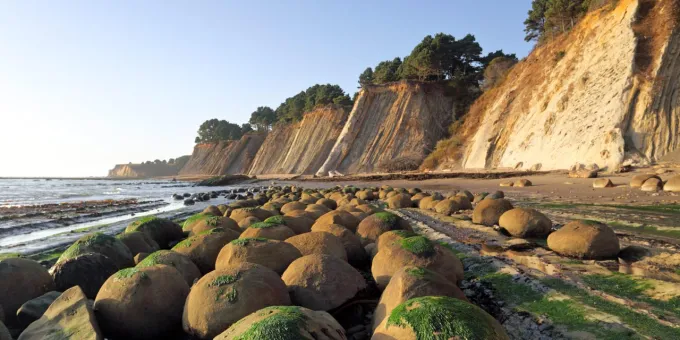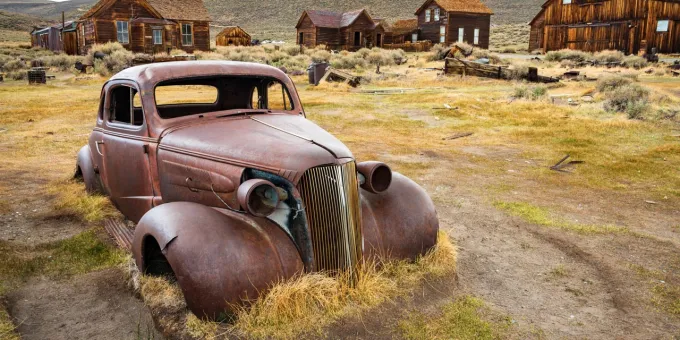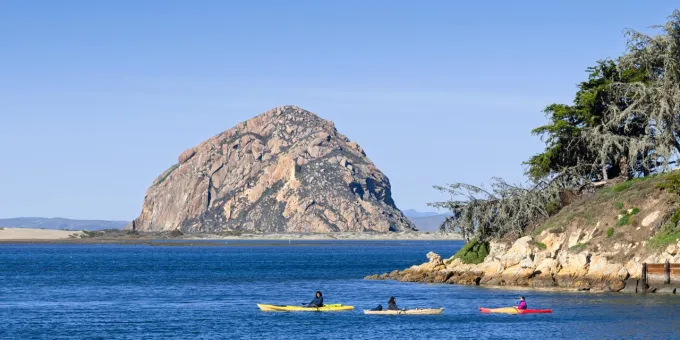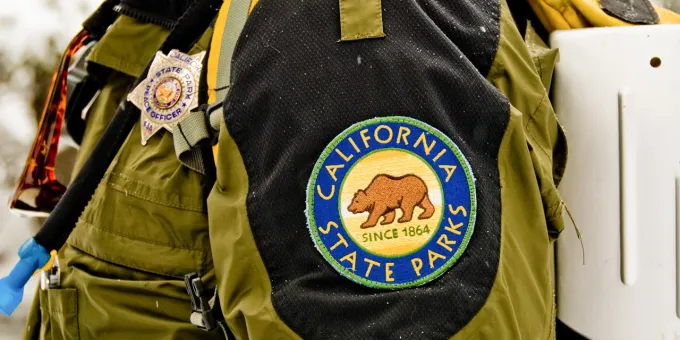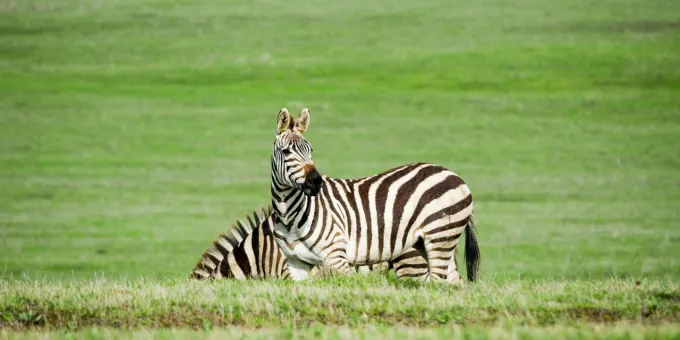When it comes to preserving precious places, California goes all in. The nation’s largest state park system has a whopping 280 parks including the latest addition to the collection: Dos Rios Ranch, a 2,500-acre Modesto property at the convergence of the San Joaquin and Tuolumne Rivers. The new state park will welcome anglers, kayakers, and picnickers and provide a key habitat for chinook salmon, monarch butterflies, and migrating birds. Plus, a new Digital Passport Program, which allows travelers to track visits to parks and collect badges for every one of them. Want to know what treasures lie in California state parks? Take our A to Z tour.
A Is for Avenue of the Giants
Tunnel through an ancient old-growth forest on this 31-mile drive through Humboldt Redwoods State Park, where 300-foot-plus redwoods eclipse the sun. Get even closer to these behemoths with an easy walk in Founder’s Grove.
B Is for Bowling Ball Beach
You can’t see them until the tide recedes, but there’s no mistaking the 100-ish bowling balls—known as concretions—on Schooner Gulch State Beach in Mendocino County. A half-mile walk leads to this assemblage of round rocks, some as large as three feet in diameter. The sandstone spheres get their shape from millions of years of weathering.
C Is for Castle Dome
Jagged granite spires appear to pierce the sky at Castle Crags State Park near Redding. Most people see these mysterious summits only from afar, but intrepid hikers can tackle a thigh-burning three-mile ascent to the base of Castle Dome’s bald pate.
D Is for the Donner Party
Three years before the Gold Rush, 87 pioneers driving ox-drawn wagons took what they thought was a shortcut while migrating west. A series of mishaps left the group stranded in an epic snowstorm, forcing them to camp at Donner Lake. Only 46 survived. The Emigrant Trail Museum at Donner Memorial State Park tells their shocking stories.
E Is for Elk
Two types of elk roam in California. There are Roosevelt elk—largest of all North American elk—and tule elk, a smaller cousin. See 1,000-pound Roosevelts bearing four-foot-high antlers at Prairie Creek Redwoods, Humboldt Lagoons, and Sinkyone Wilderness state parks. Tule elk graze farther south at Tule Elk State Natural Reserve, Henry W. Coe State Park, and Pacheco State Park. During the autumn rut, males of both species battle over mating rights with head-to-head antler clashes.
F Is for Fannette Island
In Lake Tahoe’s Emerald Bay State Park, paddle a kayak or motor a boat to Fannette Island, then hike to its highest point. You’ll find the remains of a stone teahouse where the 1920s gilded class sipped Earl Grey while gazing across the lake’s azure waters.
G Is for Ghost Town
There was no rowdier place in 1880s California than Bodie, an eastern Sierra boomtown. The boom quickly went bust, and now Bodie State Historic Park is California’s largest unrestored ghost town. Peek into the windows of nearly 200 deserted buildings—including a church, barbershop, saloon, and schoolhouse.
H Is for Horses
More than 70 state parks allow horseback riding on their trails. Even if you don’t own a trusty steed, you can join a guided ride along the North Coast’s winsome coastline at Tolowa Dunes State Park (Crescent Trail Rides), MacKerricher State Park (Ricochet Ridge Ranch), or Manchester State Park (Ross Ranch Stables).
I Is for Island
A half-hour ferry ride from San Francisco, Angel Island State Park encompasses the Bay Area’s most exclusive real estate. Rent bikes and pedal the island’s five-mile Perimeter Road for incomparable views of the Golden Gate Bridge, Alcatraz, Tiburon, the Bay Bridge, and downtown San Francisco’s skyscrapers.
J Is for Joshua Tree
Joshua Tree National Park isn’t the only place where you can cozy up to Joshua trees. North of Los Angeles, Saddleback Butte State Park and Arthur B. Ripley Desert Woodland State Park protect impressive stands of this spindly, instantly recognizable agave.
K Is for Kayak
There’s no better way to view wildlife than from the seat of a kayak. On the Central Coast, paddle alongside seals and sea otters on Morro Bay State Park’s glassy waters, or join a guided tour from Monterey State Beach to Lovers Point. In Dana Point, cruise the dolphin-rich coast of Doheny State Beach. In Lake County, launch a kayak at Kelseyville’s Clear Lake State Park for the chance to see more than 300 bird species.
L Is for Limestone
On a guided tour of Mitchell Caverns, you’ll enter a glittering netherworld of stalactites, stalagmites, columns, and curtains. Tucked into a cliff in the Mojave Desert, the spectacular limestone caves of Providence Mountains State Recreation Area were “discovered” in 1929. But for centuries prior, the Chemehuevi called the side-by-side cavern openings “The Eyes of the Mountain.”
M Is for Mansions
If you were a member of California’s moneyed class between 1850 and 1930, you needed a mansion to match your status:
John Bidwell made a fortune in the Gold Rush and founded the city of Chico. In 1868, he built an Italianate mansion with 26 rooms, lavish furnishings, and a grand piano that was shipped around the Horn. Take a tour at Chico’s Bidwell Mansion State Historic Park.
See the luxe lodgings of the Big Four railroad baron, California governor, and Stanford University founder at Sacramento’s Leland Stanford Mansion State Historic Park. Stanford’s 19,000-square-foot Renaissance Revival home boasts 17-foot ceilings, crystal chandeliers, carved woodwork, and gold-leaf mirrors.
At Lake Tahoe’s Ed Z’berg Sugar Pine Point State Park, the Hellman-Ehrman Mansion was built by a San Francisco banking magnate. The Craftsman-style home has eight bedrooms, a grand spiral staircase, leaded glass cabinets, and a covered porch overlooking the lake.
Scandinavian-style Vikingsholm at Emerald Bay State Park was built for Lora Knight, a 64-year-old heiress who loved Nordic architecture. Her 38-room “castle” is adorned with hand-hewn timbers, stained-glass windows, dragon carvings, and a sod roof planted with wildflowers.
N Is for Native American
At Lancaster’s Antelope Valley Indian Museum, 8,000 objects from 120 Native American cultures are on display, including woven baskets, infant cradleboards, bone fishhooks, and stone projectile points. They’re housed in an architectural wonder—a 1930s Tudor-style chalet built on top of Piute Butte’s granite boulders. To reach the second floor, climb through a cleft in the rock.
O Is for Oranges
In 1873, Eliza Tibbets planted cuttings from a Brazilian orange tree in her Riverside backyard. Two decades later, the navel orange ruled Southern California’s citrus empire. Take a tour of California Citrus State Historic Park to learn how oranges sparked the “second Gold Rush.”
P Is for Passport
Lifelong learners, rejoice. California State Parks offers a $50 historian passport that gets you and three friends into 34 state historic parks for one year.
Q Is for Quarry Cove
When the tide recedes below 1.5 feet, walk the gentle Bluff Trail at Montaña de Oro State Park in San Luis Obispo County. At Quarry Cove, you’ll discover a real-life aquarium where sea stars, hermit crabs, and sea anemones thrive on an intertidal shelf.
R Is for Rock Climbing
Near San Francisco, climbers strut their stuff on Swiss cheese–like sandstone formations at Castle Rock State Park. At Riverside’s Lake Perris State Recreation Area, climbers tackle Big Rock, a 180-foot-high granite monolith. The steep volcanic cliffs at Malibu Creek State Park host more than 100 bolted sport climbs.
S Is for Slot Canyon
Anza-Borrego Desert State Park, located in eastern San Diego County, bares its soul at The Slot, a twisting siltstone canyon with narrow passages. An easy two-mile hike reveals the earth’s crust sliced open and its inner layers revealed through faulting and weathering.
T Is for Torrey Pines
The world’s rarest pine tree graces the badlands at Torrey Pines State Natural Reserve in La Jolla. Contorted by salty air and stiff ocean breezes, Pinus torreana stands tall against a backdrop of sandstone cliff s. Only 3,000 remain in the world.
U Is for Utopia
Colonel Allensworth State Historic Park preserves California’s only town that was founded, financed, and governed solely by African Americans. The San Joaquin Valley settlement was the 1908 vision of former slave and Baptist minister Colonel Allen Allensworth, who envisioned a community where Blacks could live free from oppression. Walk past the two-room schoolhouse, library, general store, barbershop, and church, and listen to a cell phone audio tour about this self-sustaining town that was called a Black utopia.
V Is for Volcanic
Ahjumawi Lava Springs State Park’s lava-flow landscape in Shasta County was created by eruptions from the Medicine Lake Volcano about 1,000 years ago. More than 20 miles of trails lead past lava tubes and jagged basalt outcrops, but you can’t access them without a boat. The dry land is bounded by interconnecting ponds, marshes, and waterways.
W Is for Watts Towers
Simon Rodia spent 34 years building a monumental art installation in his L.A. backyard. Using no scaffolding or machinery, the self-taught artist constructed 17 steel spires rising to nearly 100 feet, then adorned them with found objects like rocks, seashells, glass. When he finished, he handed his house keys to his neighbor and moved away. See his masterpiece at Watts Towers of Simon Rodia State Historic Park.
X Is for Xenolith
You don’t need to be a geology nerd to find rocks-within-rocks embedded in the canyon walls of South Yuba River State Park. Search for xenoliths—rock fragments trapped in a larger bed of host rock—while hiking the Buttermilk Bend Trail along the emerald-green Yuba’s swirling waters.
Y Is for Yurt
Ditch the dirt and camp in a yurt. Bothe-Napa Valley State Park’s 10 circular canvas structures are more like houses than tents: Enter through a hinged door, gaze out a curtained window, and sleep in a queen bed. Sure, there’s no electricity and the restroom is 50 feet away, but you’re nestled in an enchanted forest of maples, oaks, and bay laurels.
Z Is for Zebra
Drive near Hearst San Simeon State Park and you might think you’ve detoured to the African savanna. Nearly a century ago, newspaper tycoon William Randolph Hearst purchased two dozen zebras for his private zoo. After a storm knocked down their enclosure, the striped equines ranged freely, and today 150 of their descendants graze on San Simeon’s coastal prairies.
